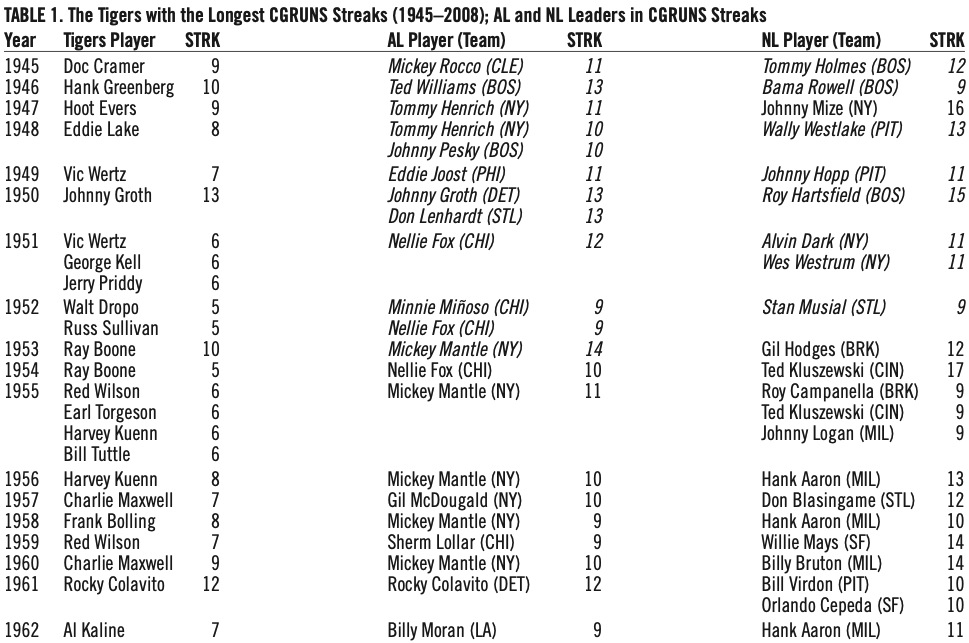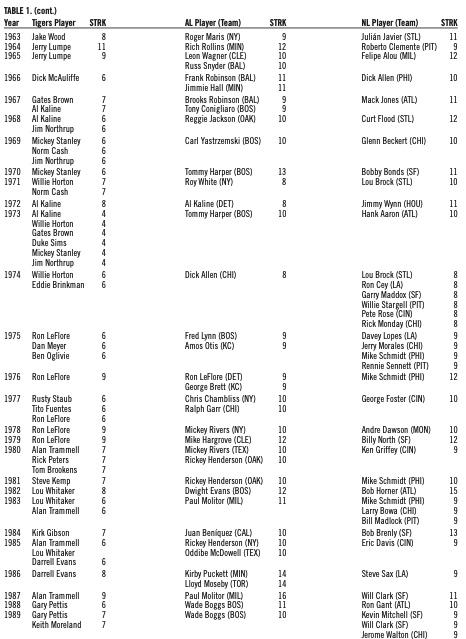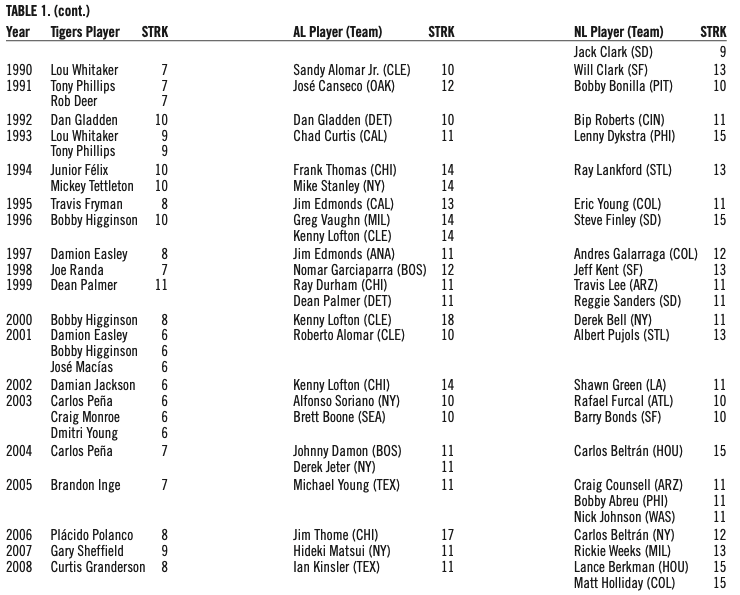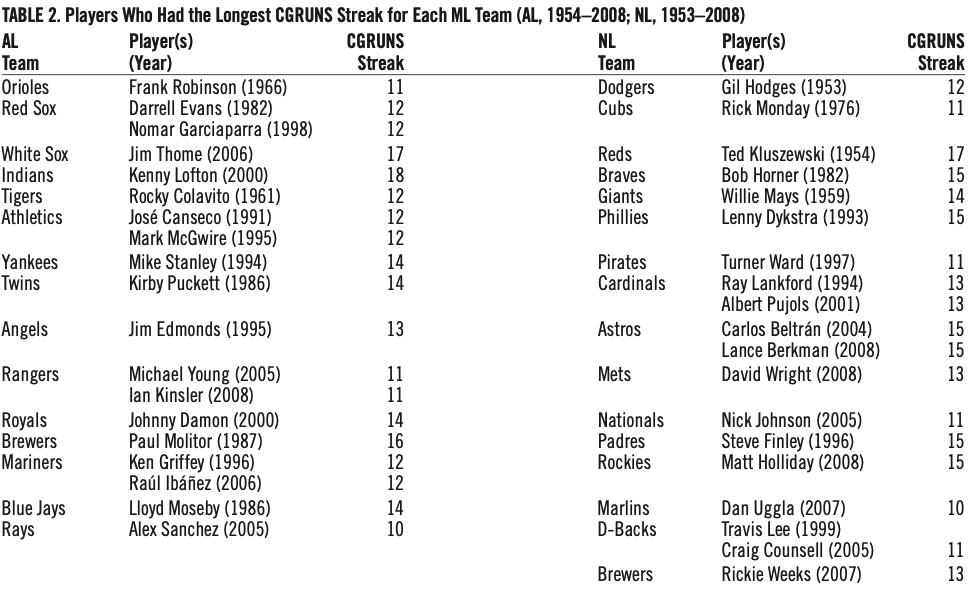The Longest Streaks of Consecutive Games in Which a Detroit Tiger Has Scored a Run
This article was written by Herm Krabbenhoft
This article was published in 2008 Baseball Research Journal
In another article, I describe my findings on the accuracy of Major League Baseball’s official runs-scored statistics for each Detroit Tigers player for the period 1945—2007.1 There I report that I discovered—and corrected—26 runs-scored errors affecting 19 players, including four Hall of Famers. Subsequently the Elias Sports Bureau (the official statisticians for MLB), based on the indisputable supporting documentation I provided, approved each of the corrections/changes I proposed to the official baseball records.1 Thus, having established an accurate, official game-by-game runs-scored database, I was able to ascertain reliably the longest Consecutive Games RUN Scored (CGRUNS) streak achieved by each Detroit Tigers player in each season during the period from 1945 to the present. The results of my CGRUNS streak research are described in the present article.2
HISTORICAL BACKGROUND
The reported record for the longest CGRUNS streak in the American League is 18, currently held by Red Rolfe and Kenny Lofton.3,4 Rolfe scored at least one run in 18 straight games for the New York Yankees during the 1939 season. Lofton tallied at least one marker in 18 consecutive games for the Cleveland Indians in 2000.5 The record for the longest CGRUNS streak in the National League is 24, by Billy Hamilton of the 1894 Philadelphia club.3,4 The modern (i.e., post- 1900) National League record for the longest CGRUNS streak is 17, held by Rogers Hornsby and Ted Kluszewski.3 Hornsby scored at least 1 run in each of 17 straight games for the St. Louis Cardinals in 1921. Kluszewski equaled that mark for the Cincinnati Redlegs in 1954.6
The record for the longest CGRUNS streak for the Detroit Tigers has apparently not been previously reported.
RESEARCH PROCEDURES
In order to manage my longest CGRUNS streak project efficiently, I divided the hundred-plus years of Tigers history into three periods: 1945—present, which I call Phase One; 1920—44, which I call Phase Two; and 1901—19, which I call Phase Three. This article deals with Phase One.
To ensure that my determinations of the longest CGRUNS streaks were accurate, I enlisted the help of Dave Smith of Retrosheet and asked him to write a computer program that would extract the longest CGRUNS streaks for each MLB player in each season of the Retrosheet database (1957—2006 at that time) according to the following criteria:
Games included:
- any games in which the player had at least one plate appearance
- any games in which the player was a pinch-runner
Games excluded:
- any games in which the player was used only as a fielder
- any games in which the player was announced as a pinch-hitter but was then replaced by another pinch-hitter
Dave graciously wrote the requested program. By comparing my manually generated CGRUNS-streak results with his computer-generated results for the 1957—69 Detroit Tigers, he was able to eliminate the few kinks and glitches that cropped up in the early versions of his program, and I was able to correct a handful of transcription errors I had made in compiling the results from the corrected official day-by-day (DBD) records (and the Retrosheet daily records).
Before proceeding to the results of my CGRUNS-streak research, I should explain the criteria I used to ascertain what constitutes a CGRUNS streak (or, in other words, what terminates a CGRUNS streak). The official rules of Major League Baseball do not specifically cover CGRUNS streaks.7 Therefore, I used the following guidelines to define the extension or termination of a CGRUNS streak:
If a player scores at least one run in a game, that game extends the CGRUNS streak.
If a player completes at least one plate appearance in a game but does not score at least one run, that game terminates the CGRUNS streak.8
If a player is used only as a pinch-runner in a game and does not score at least one run, that game terminates the CGRUNS streak.
If a player is used only as a defensive player in a game (and thus does not have a completed plate appearance), that game does not terminate the CGRUNS streak.
If a player is announced as a pinch-hitter and is then replaced by another pinch-hitter (and thus does not have a completed plate appearance), that game does not terminate the CGRUNS streak. Similarly, if a player enters the game as a pinch-hitter, but, before he can complete his plate appearance, the inning ends via a caught-stealing or a pickoff, that game does not terminate the CGRUNS streak.
The critical aspect to these guidelines is that, if a player had at least one opportunity to score a run in a game, he must have scored at least one run in that game in order to extend his CGRUNS streak; if he had at least one opportunity to score a run in a game and did not score at least one run in that game, his CGRUNS streak terminated.8
RESULTS AND DISCUSSION
Table 1 lists the player(s) who assembled the longest CGRUNS streak for the Tigers in each season during the period 1945 through 2008. To provide some perspective, I’ve included the players who put together the longest CGRUNS streak from each league for each season.
For the AL (1954—2008) and the NL (1953—2008), Dave Smith’s Retrosheet database program identified the players who assembled the longest CGRUNS streak for each league in each season. In addition, the “Streak Finder” tool at Baseball-Reference.com was used to ensure that no errors were made in transcribing the CGRUNS-streak information.
For the period 1945—52/’53 period, I examined the official day- by-day records of players deemed “likely to have assembled a significant CGRUNS streak.” The domain of “likely players” for each league consisted of the top 60 players in most runs scored (i.e., generally all players with at least 35 runs scored). Two important points with regard to AL and NL leaders in longest CGRUNS streaks for the 1945—52 / ’53 period: because (A) the domains did not include every player in the league (as was the case for the domains with the Retrosheet database program) and (B) the accuracy of the runs- scored statistics in the official records of the players was unverified, the leaders presented in the columns for the AL (1945—53) and the NL (1945—52) have not yet been absolutely determined.9 Accordingly, those players are presented in italic (except for the 1947 NL leader, Johnny Mize, who according to other sources [reference 6] is the absolute leader and therefore not italicized).
Table 1 shows that in 1950 Johnny Groth compiled the longest CGRUNS streak during the 1945—2008 period for the Detroit Tigers— he scored at least 1 run in 13 straight games from August 14 through August 26.
Note that using the uncorrected official DBD records yields a different result. According to those records, Hank Greenberg had a 14-CGRUNS streak in 1946—from September 14 through September 28. However, the Greenberg—Mullin mixup error in the game of September 18, 1946 (as described in the companion article) affects directly the identity of the player who assembled the longest CGRUNS streak for the Tigers during the 1945—2007 period.1 Thus, Greenberg did not score a run in the September 18 game, and therefore his longest CGRUNS streak in 1946 was actually 10 games, not 14. And, because Greenberg did not have a bona fide 14-CGRUNS streak in 1946, Ted Williams actually assembled the longest CGRUNS streak—a 13-gamer (verified by newspaper box scores) in the AL/NL that season.
Next in line behind Groth for the longest CGRUNS streaks by Tigers players are Rocky Colavito (12 in 1961), Jerry Lumpe (11 in 1964), Dean Palmer (11 in 1999), Greenberg (10 in 1946), Ray Boone (10 in 1953), Dan Gladden (10 in 1992), Junior Félix (10 in 1994), Mickey Tettleton (10 in 1994), and Bobby Higginson (10 in 1996).
The Detroit Tigers players who captured the most trophies for the longest CGRUNS streak (among Tigers players) during the 1945— 2008 period are Al Kaline, Ron LeFlore, and Lou Whitaker, who claimed five blue ribbons each.
Next in line behind Kaline, LeFlore, and Whitaker for the most CGRUNS crowns for the Tigers are Alan Trammell (4), Jim Northrup (3), Mickey Stanley (3), Willie Horton (3), and Bobby Higginson (3). You can also see that a Tigers player compiled the longest CGRUNS streak among all American League players five times during the 1954—2008 period—Colavito (12 in 1961), Kaline (8 in 1972), LeFlore (9 in 1976), Gladden (10 in 1992), and Palmer (11 in 1999). The CGRUNS streaks achieved by Colavito in 1961 and by Palmer in 1999 were also the longest in the major leagues those years.
With regard to the information on the non-Tigers players provided in table 1, it may be of interest to point out the following: The AL players with the three longest CGRUNS streaks during the 1954—2008 period are Kenny Lofton (18 in 2000), Jim Thome (17 in 2006), and Paul Molitor (16 in 1987). In terms of having assembled the longest CGRUNS streak the most times, Mickey Mantle leads the way with four crowns—11 in 1955, 10 in 1956, 9 in 1958, and 10 in 1960. The “Commerce Comet” also fashioned the longest (currently known) CGRUNS streak for the AL in 1953 with 14.
The NL players with the longest CGRUNS streaks during the 1953— 2008 period are Ted Kluszewski (17 in 1954), Bob Horner (15 in 1982), Lenny Dykstra (15 in 1993), Carlos Beltrán (15 in 2004), Lance Berkman (15 in 2008), and Matt Holliday (15 in 2008). With respect to being the longest-CGRUNS-streak leader the most times, Hank Aaron and Mike Schmidt each captured the longest- CGRUNS-streak throne four times—Aaron with 13 in 1956, 10 in 1958, 11 in 1962, and 10 in 1973; Schmidt with 9 in 1975 (in a four- way tie), 12 in 1976, 10 in 1981, and 9 in 1983 (in a three-way tie).
For comparison, table 2 presents the MLB team player(s) who assembled the longest CGRUNS streak during the past 55 years. The information in table 2 is derived from the results generated by Dave Smith’s database program.
Because the current Retrosheet database includes all seasons—and, therefore, all players—from 1954 onward, the team leaders for the “expansion” clubs (i.e., the Angels, Rangers [including the 1961—72 Washington Senators], Royals, Brewers [including the 1969 Seattle Pilots], Mariners, Blue Jays, and Rays in the American League, and the Astros, Mets, Nationals [including the 1969—2004 Montreal Expos], Padres, Marlins, Rockies, Diamondbacks, and Brewers in the National League) are the absolute all-time team leaders.
With respect to the all-time team leaders for the longest CGRUNS streak for the “original” MLB clubs (i.e., the Orioles [including the 1901 Milwaukee Brewers and the 1902—53 St. Louis Browns], Red Sox, White Sox, Indians, Tigers, Athletics [including the 1901—54 Philadelphia and 1955—67 Kansas City franchises], Yankees [including the 1901—2 Baltimore Orioles], and Twins [including the 1901—60 Washington Senators] in the junior circuit, and the Dodgers [including the 1901—57 Brooklyn franchise], Cubs, Reds, Braves [including the 1901—52 Boston and 1953—65 Milwaukee franchises], Giants [including the 1901—57 New York franchise), Phillies, Pirates, and Cardinals in the senior loop), table 3 presents the information I’ve obtained by examining the official DBD records of more than 3,000 player-seasons for players deemed likely to have had a substantial CGRUNS streak during the period 1901—53.
I must point out that, because I have not yet checked the official DBD records of every MLB player from the 1901—53 period, the players listed in table 3 are merely those currently known by me to have the longest CGRUNS streaks for their team.10 Nonetheless, table 3 is an interesting list of players, nine of whom have been elected to the Hall of Fame.
Of particular interest to me is my finding that Hank Greenberg of the 1940 Tigers achieved a 15-CGRUNS streak—verified by newspaper box scores. Greenberg’s 15-CGRUNS streak is two games longer than the 13-gamer that Johnny Groth put together in 1950.
CONCLUSION
For Phase One of my program to ascertain the longest CGRUNS streak for each Detroit Tigers player, I found that Johnny Groth assembled the longest CGRUNS streak during the 1945—2008 period (table 1). For comparison, I also identified the player(s) who put together the longest CGRUNS streak for each league. And, for additional perspective, I also determined the player(s) with the longest all-time CGRUNS streak currently known for each major-league team (tables 2 and 3).
Concurrent with my research on the longest CGRUNS streaks for the 1945—2008 Detroit Tigers, I have also pursued the longest Consecutive RUN Batted In (CGRUNBI) streaks. The results of that investigation will be published in due course.11
HERM KRABBENHOFT, a SABR member since 1981, had as his first baseball glove a MW (Montgomery Ward) Sporting Goods Model 4205 Joe Gordon Personal Model; his first baseball bat was an Adirondack Vic Wertz (two-tone) model. In the field, Krabbenhoft still uses his favorite glove, a JC Higgins model 1624 Professional Model (no player endorsement), which he got in 1957. At the plate, he currently uses an authentic Hillerich & Bradsby Co. model 125 Walt Streuli Louisville Slugger bat, style S2 (Vern Stephens).
Acknowledgments
With tremendous gratitude I thank the following individuals for their superb contributions to my CGRUNS-streak research program: Steve Hirdt, Seymour Siwoff, and John McCarthy of the Elias Sports Bureau; Dave Smith of Retrosheet; and, at SABR, David Ball, Steve Boren, Cliff Blau, Bob Buege, Keith Carlson, Clem Comly, Bill Deane, Chris Eckes, Bob McConnell, Austin Macdonald, Rick Riccardi, and Dixie Tourangeau. I also express my appreciation to Gary Stone for his invaluable help with photocopying the official DBD records of hundreds of players and for insightful discussions.
Notes
The longest CGRUNS streak information for the years 1953/1954—2008 presented in tables 1 and 3 and all of the longest CGRUNS streak information presented in table 2 was obtained free of charge from and is copyrighted by Retrosheet. Interested parties may contact Retrosheet through its website, www.retrosheet.org.
-
H. Krabbenhoft, “The Authorized Corrections of Runs-Scored Errors in the Official Baseball Records (1945—2007) for Detroit Tigers Players,” Baseball Research Journal 37 (2008).
-
Some of the results described here were first announced in presentations at the meeting of the Don Lund SABR Chapter in Detroit (H. Krabbenhoft, “Charlie Maxwell—Still Scoring Runs for the Tigers,” 24 February 2007) and at the SABR National Convention in St. Louis (H. Krabbenhoft, “Approved Corrections to the Official Baseball Records for Runs and RBI by Detroit Tigers Players [1945—2006],” 26—29 July 2007).
-
S. Siwoff, The Elias Book of Baseball Records (New York: Elias Sports Bureau, 2008), 12.
-
The Complete Baseball Record and Fact Book, ed. S. Gietschier (St. Louis: Sporting News Books, 2008), 18.
-
For a time, Nellie Fox was credited with the AL record. Thus in the 1956 and 1957 editions of One for the Book (the direct precursor of The Complete Baseball Record and Fact Book), Nellie Fox of the Chicago White Sox was listed as the AL record holder with a 19-CGRUNS streak in 1954 (May 21 through June 9). However, in the 1958 edition (and all subsequent editions), Rolfe was again listed as the AL record holder. Similarly, in the 1957—64 editions of The Little Red Book of Baseball (the direct precursor of The Elias Book of Baseball Records), Nellie Fox was listed as the AL record holder with a 19-CGRUNS streak in 1954. However, in the 1965 edition (and all subsequent editions), Rolfe was again listed as the AL record holder. In actuality, Fox had an 8-CGRUNS streak (May 21 through May 29) and a 10-CGRUNS streak (May 31 through June 9); he did not score a run in the game he played on May 30.
-
Prior to my CGRUNS-streak-research efforts, Ted Kluszewski was credited as being the sole holder of the post-1900 record for the longest CGRUNS streak in the National League. Thus, in the 2007 edition of The Elias Book of Baseball Records (12), only Kluszewski was listed. That was the case for all previous editions (i.e., all the way back to the 1972 edition) as well as its direct precursor (The Little Red Book of Baseball), all the way back to the 1955 edition. In the 1948—54 editions of The Little Red Book of Baseball, Johnny Mize is listed as the sole holder of the NL record for the longest CGRUNS streak: 16 games in 1947. In the 1934—47 editions, Max Carey (in 1924) and Fred Lindstrom (in 1927) are listed as coholders of the NL record for the longest CGRUNS streak: 15 games. In the 1929—33 editions, Carey is listed as the sole holder of the NL record for the longest CGRUNS streak: 15 games in 1924. The record for scoring runs in consecutive games was not included in the 1926—28 editions. On January 28, 2007, while examining the 1921 official DBD records of Rogers Hornsby, I discovered that he had a 17-CGRUNS streak (July 3 through July 20). I proceeded to confirm the findings in the official DBD records by reference to the box scores presented in the New York Times as well as in the Retrosheet database. I communicated this information via e-mail (28 January 2007) to Seymour Siwoff of the Elias Sports Bureau. Seymour contacted me on January 29 and informed me that pursuant to my message he had just finished his own in-house box-score check and that it had corroborated my finding that Hornsby did indeed have a 17-CGRUNS streak in 1921. Unfortunately, Hornsby’s post-1900 NL- record 17-CGRUNS streak was inadvertently omitted in the 2008 edition of The Elias Book of Baseball Records (12). Fortunately, it is scheduled to be included in the 2009 edition.
-
The Official Baseball Rules (copyright 2008 by the Commissioner of Baseball) are available online at mlb.com. “Rule 10.23 Guidelines for Cumulative Performance Record” deals with consecutive streaks: consecutive hitting streaks, consecutive-game hitting streaks, and consecutive-game playing streaks. There is no reference to consecutive-game run-scoring streaks. With regard to consecutive-game hitting streaks, the rules state, “A consecutive-game hitting streak shall not be terminated if all of a batter’s plate appearances (one or more) in a game result in a base on balls, hit batsman, defensive interference or obstruction or a sacrifice bunt. The streak shall terminate if the player has a sacrifice fly and no hit.” With regard to consecutive-game playing streaks, the rules state, “A consecutive-game playing streak shall be extended if a player plays one half-inning on defense or if the player completes a time at bat by reaching base or being put out. A pinch-running appearance only shall not extend the streak.”
-
There can be situations in which a player completes at least one plate appearance in a game without scoring a run and yet that game does not terminate the CGRUNS streak. For example, consider the following scenario: The player is used as a pinch-hitter and gets on base by being hit by a pitch on the first pitch he receives; the player is then immediately replaced by a pinch-runner. Because the player did not have an opportunity to score a run (the ball is dead upon hitting the batter), that game does not terminate his CGRUNS streak. Another special case is when the player is used as a pinch-hitter and completes his sole plate appearance by hitting a sacrifice bunt. An argument can be made that, because a sacrifice bunt does not terminate a consecutive-game hitting streak (rule 10.23 (B)—see note 7 above), a sacrifice bunt should not terminate a CGRUNS streak. Nonetheless, for the CGRUNS-streaks research reported here, if a player had only one plate appearance in a game and that plate appearance was completed via a sacrifice bunt, that game did terminate the CGRUNS streak. My rationale for this is as follows: If a player in his only plate appearance completes a sacrifice bunt and simultaneously reaches first base as the result of an error and then subsequently scores, his CGRUNS streak would be extended; analogously, if he did not subsequently score, his CGRUNS streak would terminate. The player decides whether or not to attempt a sacrifice bunt, either on his own or on the instruction of his manager. Choosing to attempt a sacrifice bunt may be the correct strategy to follow for the betterment of the player’s team. But doing so does terminate the player’s CGRUNS streak (unless he gets on base via an error and then scores)—which is fine and proper: An individual achievement is (should) always (be) secondary to the team’s primary objective—scoring enough runs to win the game.
-
For example, using the uncorrected 1955 official DBD records results in Willie Mays’ being credited with a CGRUNS streak of 9, which was the longest CGRUNS streak in the National League (also achieved by Roy Campanella, Ted Kluszewski, and Johnny Logan). The official DBD records for Mays show that he scored at least one run in each of the 9 games he played from September 11 through September 21 [9—11, 13, 14, 16, 17, 18, 20(1), 20(2), 21(1)]. However, according to the Retrosheet daily records, Mays did not score any runs in the first game on September 21. That Mays did not score a run in the September 21(1) game is corroborated by the complete play-by-play information (Retrosheet), the game account given in the New York Times, and the box score provided in The Sporting News (28 September 1955, page 30).
-
For a list of players “Most Consecutive Games Scoring a Run, since 1893,” see The SABR Baseball List and Record Book: Baseball’s Most Fascinating Records and Unusual Statistics, ed. L. Spatz (New York: Scribner, 2007), 144. The list consists of 16 players credited with CGRUNS streaks of at least 17 games (although Jack Tobin’s 17-CGRUNS streak for the 1921 St. Louis Browns is not included); 11 of the 16 players achieved their streaks prior to 1900, including the all-time leader Billy Hamilton—a 24-CGRUNS streak with the 1894 Philadelphia NL club. With regard to Jack Tobin’s 17-CGRUNS streak in 1921 (May 16— May 31), my examination of the official AL scoresheets and the pertinent box scores presented in the New York Times shows 100 percent agreement.
-
H. Krabbenhoft, “The Longest Consecutive Games RUN Batted In streaks by Detroit Tigers Players (1945—2007),” manuscript in preparation.







